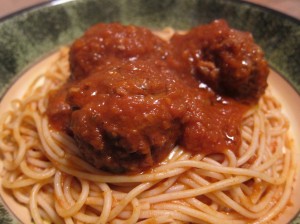
Pasta, Sugo, and Turkey Meatballs
“Oh, Lidia, this is never going to fit!” That’s me, brow furrowed, wooden spoon in hand, peering into my 3 qt. saute pan, talking to Lidia Bastianich as channeled through her book, Lidia’s Family Table. I believe I said that three times over the course of making this recipe. For some reason, it just doesn’t look like you can possibly fit any more ingredients in the pan, but by magic, and by the diligence of a good recipe tester, it all works out.
Chef Bastianich’s cookbook, true to its name, is full of recipes that will feed six or more. There are several recipes, such as this sugo, that describe one base recipe and then several variations or uses for it. For instance, she mentions this sugo is good “as a topping for a big bowl of dressed pasta,” “as a meat course with vegetables,” “in a risotto, using the sauce and broken-up meatballs,” etc. Among the expected recipes for pasta, polenta, and soup, there are some lovely vegetable recipes, such as roasted eggplant and tomato salad, and grilled corn and figs with balsamic reduction, and hearty dishes such as rabbit cacciatore.
With cinnamon, pine nuts, and raisins, the aroma and flavor of this sugo and meatballs are reminiscent of Middle Eastern cuisine. Although these ingredients typically fall into the sweet spectrum, their sweetness is tempered by the vegetables of the soffrito and the acid of the tomatoes. I found the flavors of this dish refreshingly unexpected and interesting. The sauce is thick but not cloying, and coats the pasta (should you decide to serve it with pasta) beautifully. But the most incredible thing about this dish is the texture of the meatballs themselves. While sturdy and toothsome on the outside, they are incredibly soft and moist inside. Be forewarned, this is *not* your usual tomato-y sauce with beef or beef/pork/veal meatballs. If you are looking for the typical tomato-sauce and meatballs recipe, this is not it.
This recipe fit the bill as a winter-housewarming recipe (important criteria when it’s less than 40° F. outside), a meal to have together as a family, and the very important opportunity for leftovers. This makes enough for three meals for my family of three. It would have made four, except we ate a half dozen of the meatballs standing over the pot while we were tasting…for research, of course.
The recipe begins by making a soffritto. This is a vegetable base for the sauce, made by finely mincing various vegetables and softening them in the pan, before putting the tomatoes and broth in. Although the recipe says to cook the vegetables approximately four minutes, I cooked them longer. Make sure your vegetables are very soft, or else they will simply be hard pits in your sauce, rather than disintegrating into the tomatoes. In addition, when toasting the tomato paste, make sure it gets nicely browned. The whole concoction of vegetables and tomato paste when mixed together should be slightly darker orange-brown than the color of a basketball.
You’ll want very good ventilation for frying the meatballs, else your house may take on the odor of an Italian street fair for a while. However, Chef Bastianich makes note in her book that the meatballs don’t have to be fried (although I feel you will very definitely miss the texture). If you decide not to fry them, she says to increase the sauce by at least a third (or decrease the meatballs by a third) so that they have plenty of sauce to cook in.
Do not be put-off by the length of this recipe. While there are several steps and many ingredients, the directions are all relatively simple. If you love to cook, you’ll have a lot of fun making this dish. And remember, when you’re looking into the pan feeling certain that another quart of stock or three-dozen meatballs will not ever fit into your 3 qt. pot, believe me, it will.
Note: In the cookbook Lidia’s Family Table, Chef Bastianich includes a variation of this sugo with sausage meatballs. I have omitted directions for that recipe from this text.

Long-Cooked Sugo and Meatballs
by Lidia Matticchio Bastianich
from Lidia’s Family Table
© Knopf, 2004
About 2 quarts of sugo, to cook and serve with 3 dozen meatballs.
Frying the Soffritto and Starting the Sugo
For the soffritto
– 6 tablespoons extra-virgin olive oil
– 2 medium onions (3/4 pound), minced in a food processor
– 3 or 4 plump shallots, minced in a food processor
– 2 or 3 fat garlic cloves, minced in a food processor
– 1 large carrot, minced in a food processor
– 2 large stalks celery, minced in a food processor
– 5 or 6 fresh bay leaves
– 1/4 cup tomato paste
For the sugo
– One 35-ounce can San Marzano plum tomatoes and juices, passed through a food mill (4 cups)
– 8 to 12 cups or more hot Turkey Broth, Simple Vegetable Broth, or plain hot water (recipes for the broths are in the book, I used my own vegetable stock)
– 1/2 teaspoon salt, plus more if needed
– 1 cinnamon stick
Pour the olive oil into the pan, drop in the onions and shallots, and set over medium-high heat. Stir for a minute or two, until the onions begin to sizzle.
Drop the garlic into a hot spot and spread it out to caramelize for a minute, then stir with the onions. Stir in the carrot and celery, and get them cooking; drop in the bay leaves and cook the soffritto for another 4 minutes until it is starting to dry out. Lower the heat if necessary to prevent burning.
Push the vegetables to the side and drop the tomato paste into a hot spot. Toast it for a minute or more, then blend it into the soffritto. Pour in the milled tomatoes and juices, and stir; slosh the tomato container with a cup of hot broth or water and stir that in too. Bring the sauce to a boil quickly, and cook over medium-high heat for 5 minutes or more, stirring frequently, until it has just begun to thicken.
Pour in 4 cups of the hot broth, stir it in, and note now the level of the liquid in the pan: this is about the level that the sugo should be at the very end of cooking, after the meatballs have been removed. Stir in another quart of the broth, and bring to a lively boil.
Submerge the cinnamon stick in the sauce. Cover the pot and adjust the heat to maintain a steady but gentle bubbling all over the surface of the sugo . Let it cook for at least an hour or longer, checking the pot every 20 minutes or so. It should be redicuing steadily. If it’s barely dropping, or not at all, raise the heat and set the cover ajar ot speed its concentration. If it’s dropping extremely fast, lower the heat to slow the evaporation. Add hot broth or water if needed to keep the sauce at the level you want.
Make the turkey meatballs while the sugo cooks. Once they are finished, complete the recipe as follows:
Have the sugo at a gentle simmer over low heat when the meatballs are fried and ready to go into the saucepan. Have hot broth or water on hand if needed. Drop the meatballs in one at a time; fit as many as you can in the bottom of the pan in one layer, but leave enough space to roll them around. Drop the rest of the meatballs in to make a second layer. Add hot broth or water if necessary so the meatballs are covered with liquid. Stir gently to mix the broth with the sugo – don’t break the meatballs! Cover the pan and raise the heat slightly to bring the sugo back to a simmer. Set the cover ajar and adjust heat to maintain steady simmering (but no threat of burning the meat on the bottom), and cook the meatballs for 35 to 40 minutes.
Turn off the heat and let the meatballs cool in the sugo and absorb more of its flavor (unless you need them right away). When cool, remove them to a big bowl. If the sauce is thin (probably well above the 2-quart mark), return it to a boil gradually and cook it uncovered to thicken. Stir frequently as it thickens; reduce it to the 2-quart level, or to whatever consistency you like – that’s the most important guideline. Taste the sauce during this final cooking, and add salt, if needed, or adjust the other seasonings.
Serve sauce and meatballs right away if you want. Otherwise, pack the meatballs in containers with enough sugo to cover and the rest of the sauce in separate containers. Portion them, for convenience, in the amounts you’ll use in different dishes. Store in the refrigerator for 4 days, or for several months in the freezer.
Making Turkey Meatballs with Pine Nuts and Golden Raisins
– 1 1/2 tablespoons extra-virgin olive oil
– 1 medium onion, finely chopped (about 3/4 cup)
– 1/2 teaspoon salt, plus more as needed
– 4 slices dried white bread from a sandwich or big Italian loaf
– 1 to 2 cups milk
– 3 pounds ground turkey meat
– 3 large eggs, well beaten with a pinch of salt
– 2 tablespoons chopped fresh Italian parsley
– 1 1/2 tablespoons porcini powder (to make porcini powder, place dried porcini in a spice or coffee grinder, and pulverize them as fine as possible – for more notes on porcini, see Lidia’s Family Table)
– 1/2 teaspoon freshly ground black pepper, or to taste
– 3/4 cup golden raisins, plumped in warm water and drained
– 3/4 cup pine nuts, toasted in a dry skillet
Pour the olive oil into a medium skillet, drop in the minced onions, sprinkle with a pinch of salt, and set over medium-high heat, stirring until they begin to sizzle. Lower the heat and cook for 4 to 5 minutes, stirring occasionally, until the onion is wilted and slightly dry (but not colored). Scrape out of the pan and let cool.
Break up the dry bread slices into pieces roughly an inch or two across – you should have almost 4 cups – and put them in a shallow bowl or baking dish. Pour enough milk over to cover them, and soak for 4 to 5 minutes. When the pieces are completely soft, gather them in your hands and firmly squeeze out all the milk; you should have almost 1 cup of densely packed moist bread.
Loosen up the turkey meat if it’s been compressed in packaging; spread it out in a large mixing bowl. Pour the beaten eggs on top, sprinkle on the parsley, porcini powder, salt, and freshly ground pepper. Scatter the drained raisins and pine nuts on the meat, then spread the cooled wilted onions on top. Break up the clump of wet bread, spreading little bits over the meat. Now fold, toss, and squeeze the meat and seasonings together with your hands and fingers to distribute all the ingredients evenly.
Spread the flour about 1/4 inch deep in the center of a baking sheet.
Pour vegetable oil into a large, heavy skillet or saute pan – 12 inches in diameter if possible – to a depth of at least 1/3 inch.
Scoop up a portion of meat with a small ice-cream scoop, a large spoon, or your fingers. Lightly shape the meat between your palms into 2-inch balls, a bit larger than golf balls (or whatever size you like). Drop each ball onto the floured sheet, roll it around until coated, then place it on another baking sheet. Form and flour all the meat balls in this manner.
Set the skillet over heigh heat until the oil is very hot. With tongs or a spatula, carefully transfer meatballs to the pan, as many as you can, leaving at least an inch or so between them. Cook for a minute or two, until they’ve starged to brown on the bottom, then turn them continuously – watch out for oil spatters – until golden-crusted on all sides, about 6 minutes. As they are done, transfer the fried meatballs to a baking sheet (I set them on a cooking rack atop a baking sheet to keep them dry – T). When all the meatballs are on the tray, sprinkle salt lightly over them (just a couple of pinches in all).
Note: The meatballs will finish cooking in the sauce; they are fried just until a golden crust forms. So, if you intend to eat them as is instead, be sure to fry them longer, until they are cooked through.
Before frying the next batch, turn off the heat and, with a fine-meshed skimmer or strainder, remove any browned bits from the oil. Add oil if needed to restore the 1/3 inch depth and heat it up again. (I must admit, I completely skipped this step. I found there was plenty of oil to fry 3 dozen meatballs in about four or five batches)
When all the meatballs are fried, cook them with the sugo following the instructions above.

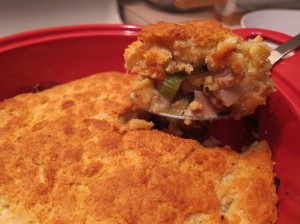
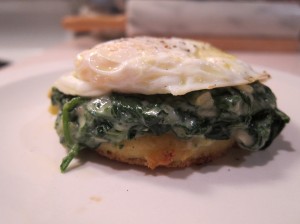

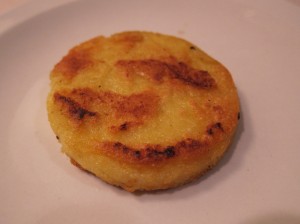
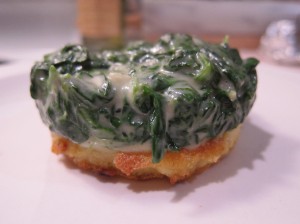
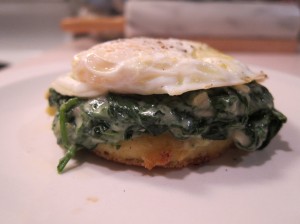
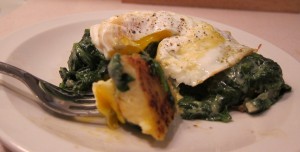
 In the first week of January, there was a tweet in my
In the first week of January, there was a tweet in my 



 Over the years I have surrounded myself with wonderful cookbooks. Cookbooks that for some reason I never cook from. I love to own them and read them, but I never seem to get around to actually using them as often as I should. I usually get an idea in my head, assemble the ingredients at the market, and throw it all together at home with, I am happy to say, better-than-passable results. I think it has something to do with my natural desire for immediate gratification, combined with my irrational fear of recipes that begin with the words “Day One.”
Over the years I have surrounded myself with wonderful cookbooks. Cookbooks that for some reason I never cook from. I love to own them and read them, but I never seem to get around to actually using them as often as I should. I usually get an idea in my head, assemble the ingredients at the market, and throw it all together at home with, I am happy to say, better-than-passable results. I think it has something to do with my natural desire for immediate gratification, combined with my irrational fear of recipes that begin with the words “Day One.” A note on the recipe: The author doesn’t say exactly how you’re supposed to get the crackly phyllo dough into the edges of the tart pan. Just squish ’em in. It’ll work out just fine. Also, a spray bottle of olive oil works wonders in place of a brush. There’s much less of a chance you’ll break your dough.
A note on the recipe: The author doesn’t say exactly how you’re supposed to get the crackly phyllo dough into the edges of the tart pan. Just squish ’em in. It’ll work out just fine. Also, a spray bottle of olive oil works wonders in place of a brush. There’s much less of a chance you’ll break your dough. Winter Squash and Leek Pie
Winter Squash and Leek Pie